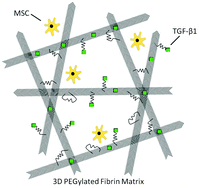Mesenchymal stem cell response to TGF-β1 in both 2D and 3D environments
Abstract
Smooth muscle cells (SMC) are critical in stabilizing developing vascular networks, and transforming growth factor β1 (TGF-β1) has been shown to promote SMC differentiation from stem cells. Previously, our lab has developed a chemically modified fibrin-based hydrogel that induces endothelial cell (EC) phenotype and network formation from human mesenchymal stem cells (hMSCs) without exogenous cytokines. Additionally, we have shown that this hydrogel system is capable of releasing growth factors in a controlled manner. In the present work, the effects of TGF-β1 on hMSCs in both monolayer and fibrin-based gel culture systems were demonstrated. The objective was to enhance SMC properties through TGF-β1 signaling for vessel stability while maintaining EC gene expression and morphology. Proliferation was decreased with higher TGF-β1 concentration in both monolayer and 3D gel cultures. EC genes were predominantly downregulated in the presence of TGF-β1 in monolayer cultures, while SMC genes were generally upregulated. In fibrin-based gels, several SMC genes were significantly upregulated at high concentrations of TGF-β1. Even at elevated TGF-β1 concentrations, no significant differences were seen in EC genes for hMSCs in gels compared to controls. Network formation and growth occurred in PEGylated fibrin gels loaded with TGF-β1 and were not significantly different from gels without loaded growth factor. Additionally, production of smooth muscle α-actin (SMA) was significantly increased in gels loaded with TGF-β1. These results demonstrate a simultaneous response of hMSCs to both the 3D biomatrix and cytokine signaling cues.


 Please wait while we load your content...
Please wait while we load your content...